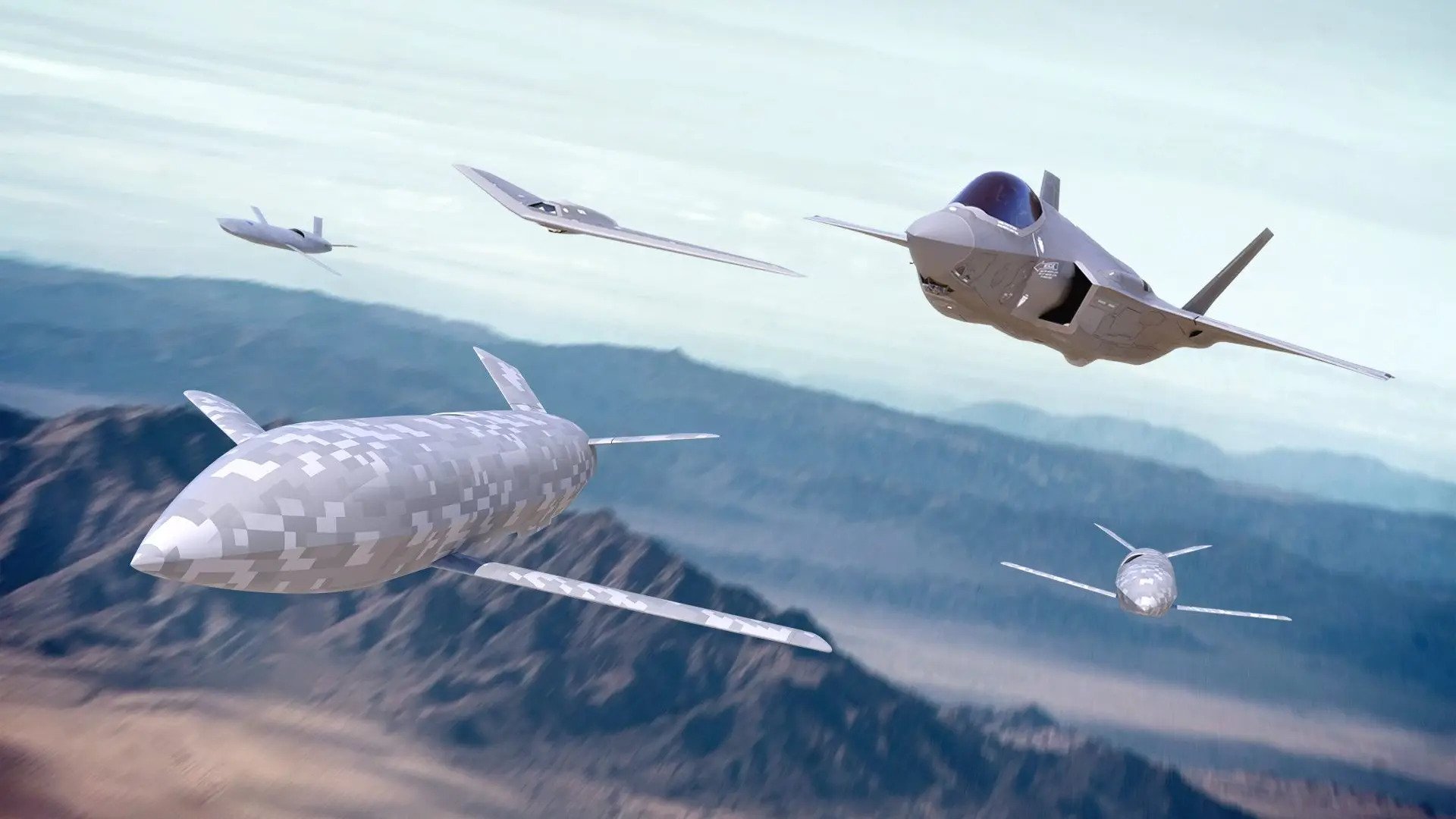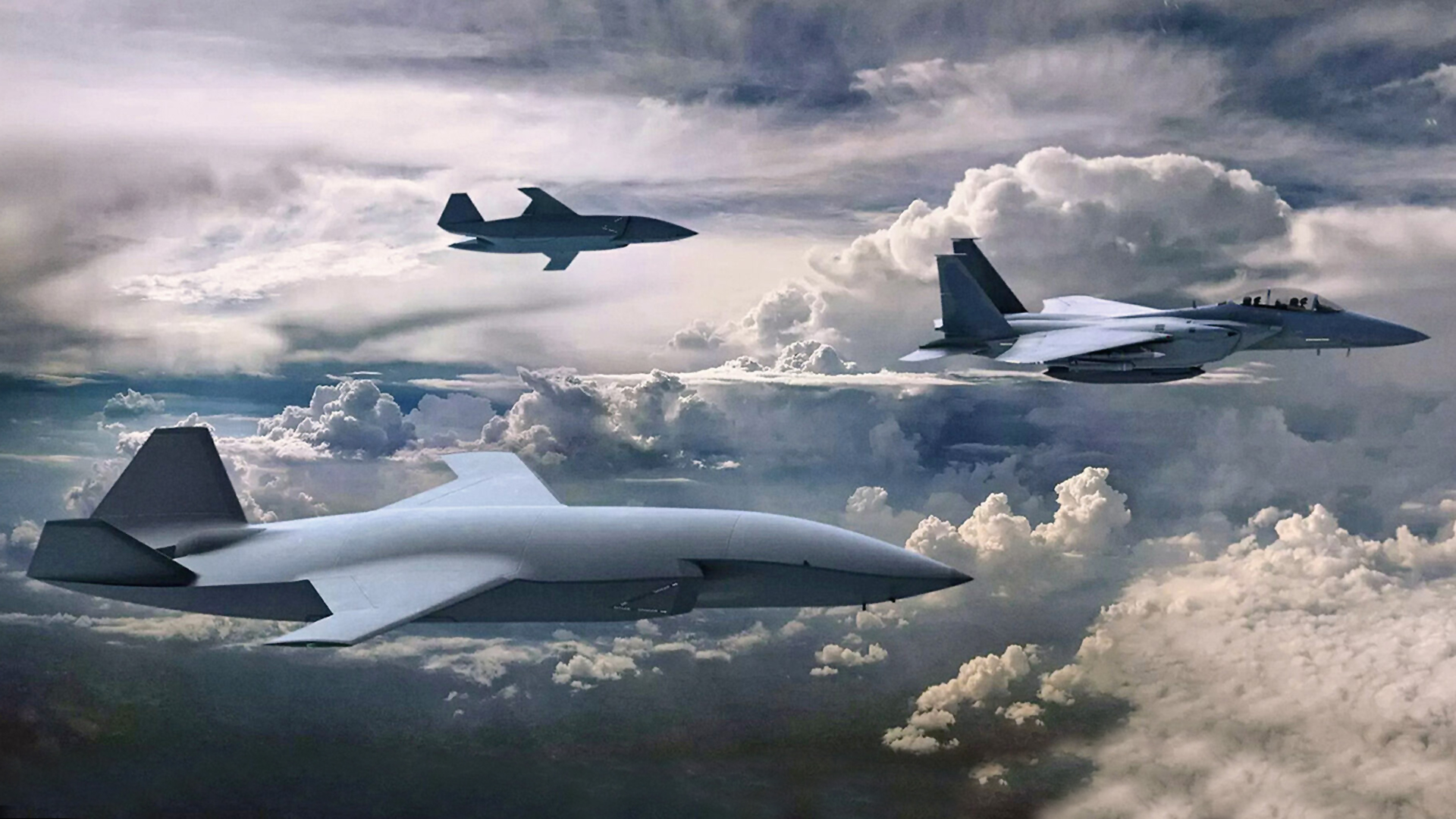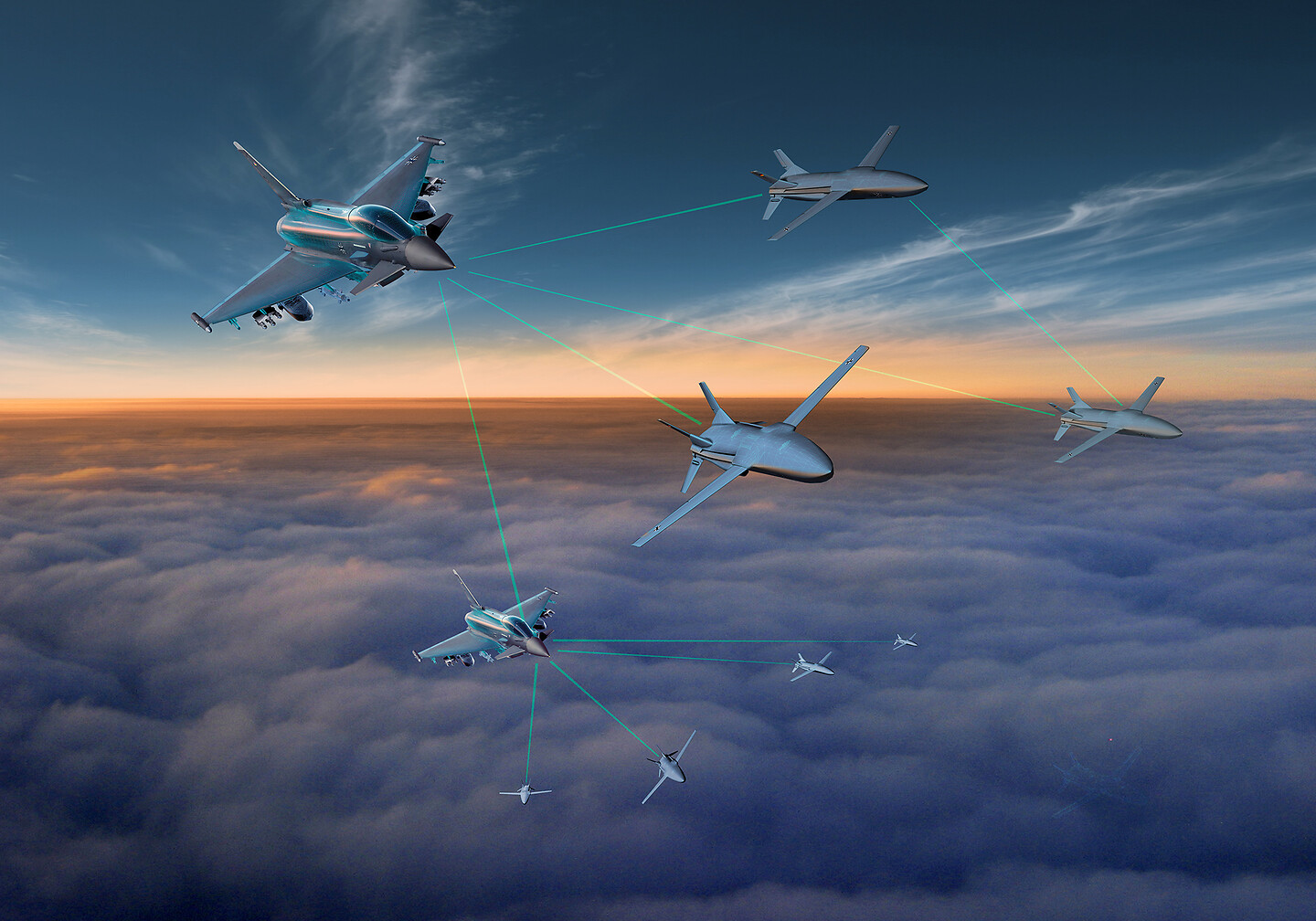Sometime in the future, the Air Force wants to see a fighter pilot be able to go into battle accompanied by as many as five drones under his or her limited control, ready to fire weapons, gather intelligence, jam communications, or serve as decoys.
But making this Collaborative Combat Aircraft (CCA) concept – a new black-budget program to team pilots with drones – a reality presents many challenges. CCAs are “something in our future,” Gen. Mark D. Kelly, commander of Air Combat Command (ACC), told a group of reporters, including from The War Zone, Wednesday during the Air and Space Forces Air, Space & Cyber conference at National Harbor, Maryland. “The discussion is, how are we going to get there?”

Over the course of the three-day conference, which also features a major industry trade show, Kelly and other Air Force leaders talked about the challenges of getting the concept off the drawing board and into fighter squadrons. Among things that have to be considered are how to build them so they are both functional and expendable, how best to test them and integrate them into units and how many a squadron might receive.
Those officials offered a deeper peak into a program that will be shrouded in secrecy to the point where it won’t even be detailed in budget documents. And they follow the announcement earlier this month by Air Force Secretary Frank Kendall that competition to procure the CCAs will begin in Fiscal Year 2024. The CCA concept is one component of the larger collaborative NGAD effort, which also includes plans to develop next-generation manned combat aircraft, weapons, sensors, networking and battle management systems, jet propulsion technologies, and more.
You can read more about that in our coverage of the announcement here.
Paying The Bills
Kelly’s command is tasked with providing fighter jets like A-10s, F-15s, F-16s, F-22s, and F-35s for combat operations, as well as homeland defense, top cover for the president, and other contingencies like beefing up U.S. presence in Europe in response to Russia’s full-on invasion of Ukraine.

At a prior panel discussion Wednesday at the AFA conference and with reporters later that day, Kelly referred to those missions as “bills” that need to be paid.
The trouble, he said, is that there are not enough squadrons to pay those bills, increasing the strategic risk from the time back in the early 1990s when the U.S. enjoyed “conventional overmatch” with 134 fighter squadrons.
“I need 60 multirole fighter squadrons to pay our day-to-day bills,” he said. “And right now, it’s challenging because I’m trying to pay that bill with 48 fighter squadrons and nine attack squadrons.” Those attack squadrons are made up of A-10 Thunderbolt II close air support jets Air Force leaders have been trying to mothball for years because they are not considered viable in a fight against China or Russia.
Kelly said that one day, CCAs will help ACC pay those bills.
“I think the long-range answer is going to be absolutely, yes,” he said when asked if CCAs will one day help the Air Force augment the squadrons. “They’re going to be able to augment. Now as far as to what degree they can give back, you know, that’s a journey that we need to go on.”
That journey should be an iterative one, said Kelly.
“Are we going to swing for the fence and try to have these things almost operational in a short amount of time? Are we going to kind of get some singles and some folks on base, try to iterate our way there? I’m an advocate to iterate our way there because I think there’s so much we don’t know.”

Looking into the near-term future, Kelly envisioned that “in two or three years, we’ll have some CCA operational tests going on. We’ll put them out, we’ll launch them out of a Tonopah or Creech, somewhere like that, where we can already launch uncrewed platforms.”
“We’ll put them on the red air side. Our weapons school students will fly against them, and one of those weapons school students is gonna say, ‘you know, this problem set would be nicer if we had them on our side.’ And maybe two rides later, they’re flying on the blue side.”
That kind of cycle, said Kelly, is “not that cosmic. We had a jammer called ‘Angry Kitten.’ It was built to be an adversary air jamming tool. And all of a sudden, the blue team said, ‘you know, hey, we kind of need that, can we have that for us?’ And so I see this iterating and testing our way into this.”
There is “no lack of opinion and perspective of what people believe a squadron is gonna look like, and what professional development is going to look like for the airmen who operate these platforms,” said Kelly. “I’m gonna tell you, I don’t know, except for the fact that I know that’s the path we’re going on.”
Advice To Industry
The so-called manned-unmanned teaming (MUM-T) concept is emerging in several different flavors, from allowing a pilot to issue high-level commands, such as “loiter here,” or “follow me” or “attack that” to offering a much less command-dependent, supportive functionality leveraging high-degrees of artificial intelligence.
The CCA capability is being developed to help counter potential adversaries like China and Russia, and present them with greater challenges in any future conflict.
“[This] raises the uncertainty that the adversary has to deal with because he doesn’t know what’s in any given aircraft,” Air Force Secretary Frank Kendall explained, according to Defense News. “He has to take each of them seriously as a threat. So whether they all carry weapons, or a subset carry weapons, he has to treat them all as if they do. He doesn’t get a choice.”
While uncrewed platforms have been working successfully for decades, the Air Force’s top weapons buyer told a group of reporters Tuesday, including from The War Zone, that the challenge is teaming them with pilots.
“There have been some early successful experiments, but they’re experiments, right?” said Andrew Hunter, Assistant Secretary of the Air Force for Acquisition, Technology, and Logistics. “They’re not operationally robust capabilities to date. It’s also challenging to have a platform that’s able to operate in denied airspace. So those are the kinds of things that we need to make sure that we’re addressing in our CCA program.”
Hunter said, “the highest priority is to field a capable CCA aircraft that can team with our manned platforms in the earliest timeframe that we can.”
That could be a single platform or multiple platforms, but Hunter said he has “some work to do with industry to identify what is the most effective mix of vehicles and mission systems, because the mission systems is a huge piece of the puzzle.”
Though Kendall said competition to build CCAs will officially kick off next year, Hunter said that, in reality, it’s already underway.
Lockheed Martin’s Skunk Works recently unveiled an entirely new proposed manned-unmanned ecosystem incorporating multiple tiers of drone designs, which could reflect, at least to some degree, the Air Force’s current internal deliberations. Northrop Grumman, by way of its subsidiary Scaled Composites, has presented its own multi-drone concept in the past. And General Atomics says its Gambit concept is aimed at CCA. In addition, Kendall has confirmed that “preliminary discussions” with Boeing were underway with a view to buying the MQ-28 Ghost Bat drone as a CCA variant. The already flying Ghost Bat, in particular, has been identified as a possible risk-reduction platform for the CCA effort, as well, which you could read more about here.

“I think industry is competing today,” Hunter said. “This is a good news story, by the way, right? A lot of them are expanding quite a bit of internal [research and development] assets, to be ready for an acquisition program.”
“There’s also interest from other services in CCA type aircraft, there’s interest from other nations, including allied nations. And so industry is designing and doing work today. And there is an implicit competition that’s underway…and all of the main industry players are aware of that. I am confident that we will be able to field something in a very relevant timeframe.”
Given the urgency to get ahead of the challenges posed by China and Russia, Hunter said the “first thing is to field something meaningful in the next several years to meet the threat. And so that’s going to be absolutely the early focus.”
However, while work is already underway, Hunter said that the Air Force will have to wait until approval of the Fiscal Year 2024 Program Objective Memorandum (POM) – a recommendation to the Defense Secretary on how the Air Force expects to allocate funding – “to really get into fielding.”
As the commander in charge of the fighter force, Kelly said that when it comes to producing CCAs, he wants industry to build flexibility into the designs.
“If I was doing a clean sheet design, I would look for something you could iterate,” he said. “I would not lock myself into it’s a sensor, can’t do anything else. It’s a jammer, can’t do anything else. It’s not armed, you’ll never arm it. I would not want to lock myself in…”
Such modularity also fits in with Kendall’s vision of both keeping costs down and keeping the enemy guessing as to what they are encountering.

Kelly also said that when he talks to defense industry partners about the way forward, “the first three things I’ll bring up are autonomy, authority and resilient comms.”
“If I build an exquisite CCA – because you know, with exquisite goes exquisite pricing – I can have a CCA that can punch into really, really highly defended piece of air space. [But] if I don’t have resilient comms, and that thing doesn’t know how to phone home, you know, I don’t get home.”
But exquisite won’t be the only avenue for CCA or even its primary focus. Because many of these drones will be designed to be expendable if necessary, being able to limit the required capabilities for each individual drone opens the door to great freedom of choice when it comes to the underlying designs, as well as how much they might cost. “Sound judgments can be made on whether the requirements are really worth the cost or not,” Kendall said at the Defense News conference.
The Air Force is looking at a price tag for the CCA drones of less than half the cost of an F-35 — which would put the most high-end CCAs at about $40 million, according to Breaking Defense. Kendall has said he would like to spend “a factor less than that” because some CCAs will doubtlessly be lost in combat.
Of course, $40 million would be at the very high end of the CCA spectrum. Lockheed Martin’s Skunk Works, for example, is developing the Speed Racer drone, which is currently viewed as a platform that will be cheap enough to be expandable. While the company didn’t provide a specific dollar figure during a recent press call, it said Skunk Works is aiming for a unit cost significantly under $2 million – and is not presently designed to be recovered.
Drone maker Kratos has said in the past that one of its goals has been to drive the price of a single XQ-58A down to around $2 million as production of those drones ramps up. It’s still unknown if realizing such an ambitious goal is feasible.

While Kendall has publicly dismissed the idea of using a more novel, iterative approach to the development of the manned NGAD combat jet, he and other Air Force officials have left the door open to doing so with the CCAs. The Digital Century Series concept, first proposed in 2019 by former Assistant Secretary of the Air Force for Acquisition, Technology, and Logistics Will Roper is one possible development and acquisition model that is often discussed in this context. Digital Century Series idea had a heavy emphasis on short development cycles, supported by advances in rapid prototyping and digital engineering, as well as small batch production, all of which you can read more about here.
“I think we can iterate pretty fast,” Kelly said. “But if we lock ourselves into ‘it must be this big and must go this far and must do these jobs, it must be this price point,’ we’d lock ourselves into that and race to the finish line. And if we find out we’re wrong, we’re going to turn around and go back to the start.”
Kelly said he agreed with Kendall that “we need to start doing and iterating and test driving some of this and get ourselves away from the PowerPoint slides. He’s right. There’s enough out there that’s mature enough that we can start iterating now.”
Listen To The Pilots
The commander of the Air Force Test Center, Maj. Gen. Evan C. Dertien told The War Zone that there are three steps to turning the CCA concept into reality.
“One is just the logistics of launching, recovery, and maintaining, how do you do that for CCAs? Two is developing the tactics and three is getting that integrated package.”
Dertein said that from his perspective, the first challenge “is just getting the trust of the aviators to figure out that they’re going to be teaming with this thing.”
Beyond that, a lot of questions need to be answered.
“How do you do the basic operations? How are you gonna launch it? How are you gonna recover it? How are you going to turn it around between sorties? What kind of maintenance does it require? How would we do that on austere fields in different theaters? If you have different platforms, what does the logistics of that look like?”
Dertien said experimenting with the heavily modified F-16D now called the X-62A, which used to have the designation NF-16D and is also known as the Variable In-flight Simulator Aircraft (VISTA), will be key to the effort.

“You need to do some of what we’re doing right now with VISTA in the experiments of how do you actually maximize collaborative combat air flying with manned or platforms to be the most effective.”
Kelly, the ACC commander, said there are bureaucratic concerns as well.
The MQ-9 Reaper today “has the autonomy to do auto takeoff, auto land,” Kelly said. However, “I don’t have the authority to land it anywhere I want in the U.S. So you can race down the track of autonomy, but if you don’t have the authority to go right with it, you have to pace those two things.”
As a result, one of the biggest early challenges, he said, will be finding places to launch and recover the CCAs. At the moment, Kelly said there are not a lot of places where he has the authority to do so, ticking off Creech Air Force Base and the Tonopah Test Range in Nevada, Holloman Air Force Base in New Mexico and Tyndall Air Force Base in Florida as places where such testing could take place.
“If there’s someplace else, I need to hear about it,” he said.
But once all that is worked out, it will be imperative, said Kelly, for the Air Force to heed the suggestions of those tasked with operating the CCAs.
“Once we start launching out of there, we’ll start getting ready to learn,” he said. “The young captains will come back and go, ‘oh, we need to do something different, a lot different. And we need a lot more of these or we need a lot more with this capability. And we need more sensing. No, no, we don’t need more sensing, we need more jamming. You know, Hey, Dad, we need to be able to arm these things forward or whatever.’”

Those pilots “will navigate us through this,” he said. “If we try to foist it on them and tell them how to do it, we’ll miss this.”
That also holds true for how many CCAs a squadron should employ.
“We will find that out,” he said. “It’s no different than the foundation of the Air Force when they first start flying. They found out that hey, flying in groups of four seems to really help in terms of firepower and mutual support.”
“We’d have to iterate with this and find out what’s the right number. What’s the right role and mission? What’s the right place to put them? What’s the right mission to give them? I think if we issue that to the captains, there’s a 0% chance to [get it right].
Contact the author: howard@thewarzone.com
